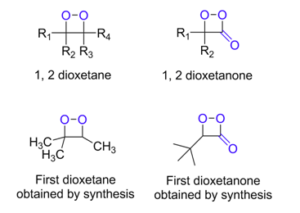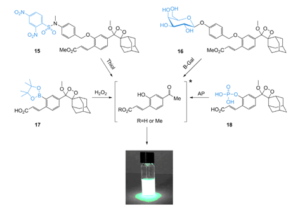By BIOSYNTH AG
Biosynth Minireview: Exploring new territories with Dioxetane Chemiluminescence
Overview:
Microbiology and organic fine biochemical CDMO and specialist supplier, Biosynth AG, has released the latest in its series of White Paper-style Product Minireviews: ‘Exploring New Territories with Dioxetanes Chemiluminescence’, which highlights the fascinating chemistry of dioxetanes and their exceptional light emission properties.
The minireview pays special attention is to recent game-changing discoveries in the chemiluminescence field. These include Biosynth’s innovative dioxetane-based AquaSpark™ substrates that now enable improved, more sensitive and at the same time cost-saving bio-tests.
A guide to dioxetane chemiluminescence
Chemiluminescence is a non-enzymatic process in which a chemical reaction produces a high energy intermediate that returns to its ground state emitting light. Several chemical structures like peroxyoxalates, acridinium salts, luminol, and dioxetanes are known to have chemiluminescent properties. Today, these compounds are used in biological, clinical, forensic and food sciences. The discovery of four membered ring peroxides as light emitters by Emil White, Frank McCapra and others paved the way for the understanding of the general concepts of chemiluminescence. Since then, an increasing number of stable dioxetanes have become available and routinely used in practical applications.
The Minireview explains the mechanism of Emissive Dioxetane Decomposition, with particular reference to the Chemically Initiated Electron Exchange Luminescence (CIEEL) mechanism, based on thermal decomposition of diphenol diperoxide. This can be also extended to the description of other chemiluminescent systems, including Firefly Luciferin (D-Luc); still one of the most efficient emitting systems.
After exploring the mechanism of the emissive dioxetane decomposition and design of CIEEL emitting Dioxetanes, the paper goes on to highlight the role of substituents at the aromatic group, and of the pH of the medium – important factors in choosing an appropriate probe for a specific test.
The Minireview then goes to summarise the main applications of dioxetane chemiluminescence, including:
- Enzymatic immunoassays: well-established applications in ELISA kits, based on dioxetane substrates like AMPPD(R) or CSPD(R) and CDP-Star(R).
- Western Blot and Nucleic Acids Assays: AMPPD®, CSPD®, CDP-Star® are routinely used in blotting techniques, allowing very low detection limits at picogram and even femtogram levels and particularly suitable for detection of a specific protein in a complex matrix like a tissue or a tissue extract.
- Biotinylated antibodies: Exploiting the strong affinity between biotin and avidine or streptavidine in several techniques including ELISA, Northern, Western, Southern blotting and affinity chromatography.
- Alkaline phosphatase vs Horseradish peroxidase: The pros and cons of the two most largely employed substrate systems for blotting and other chemiluminescent techniques but with different emission characteristics are highlighted.
- Enhancers and Blocking reagents: since Schaap’s dioxetanes are not good emitters in aqueous media, a macromolecular enhancer (usually quaternary ammonium salts like polyvinylbenzyltributylammonium chloride) is required. Often a fluorogenic dye is included in the structure of the surfactant, resulting in modulation of the maximum wavelength of emission.
- Reporter gene assays: used to study gene expression, these include chloramphenicol acetyltransferase (CAT), β-galactosidase, firefly luciferase (FLuc), alkaline phosphatase (AP) and green or red fluorescent proteins (GEP, RFP)s. Dioxetanes can also be used as detection probes, for example a substrate consisting of a β-galactose conjugate dioxetane is known in the market as Galacton Plus®, often used in combination with a Luciferase reporter gene in the commercial product also known as Dual-Light®.
The paper goes on to explore the relationship between Chemiluminescence and Bioluminescence as complementary methods for both in vitro and in vivo imaging techniques. While luminescence is undoubtedly preferred over fluorescence, due to independence from external light source and suppression of background noise, the choice between chemiluminescence over bioluminescence requires more careful evaluation. Indeed purely chemiluminescent methods are only at the beginning of their development, while in vivo bioluminescence is already well-established.
Various strategies are summarised for signal enhancement under physiological conditions, including the use of dioxetane fluorophore conjugates and the co-injection of a classic dioxetane together with an additional dye.
Discussing recent discoveries and new trends in dioxetanes chemiluminescence, the Minireview presents the advantages and potential applications of the AquaSpark™ suite of strongly chemiluminescent probes, in which remarkable increases of chemiluminescent intensity up to a maximum of 3000 times can be observed for the best among the four acrylate derivatives in comparison with the parent unsubstituted dioxetanes.
The paper presents a number of new dioxetane chemiluminescent dimensions in which the AquaSpark™ technology can be deployed, including:
- NIR Light-emitting probe: further refined probes with near infrared emission properties particularly suitable for in vivo imaging. The new probes contain a hyper-conjugated push-pull π-system based on DCMC (dicyanomethylchromone) in para position of the phenol moiety, with or without the ortho-acrylate group. The two new probes proved to be a successful example of turn-ON detection of H2O2 and β-galactosidase and highly advantageous in comparison with the traditional use of dioxetane-dyes couple. They will be extended to other enzymatic or chemical triggering systems in the future.
- Singlet oxygen detection: a further innovative application of dioxetane probes is for the detection of singlet oxygen (1O2) in biological systems; important for its connection with cellular signaling and response to stressful events.
- Cathepsin B detection: Dioxetane-based substrates have great potential for the sensing of endogenous enzymes like Cathepsin B, the lysosomal protease overexpressed in cancer cells and during inflammation. Its importance as a marker has become increasingly recognized over the years in order to control the efficacy of anticancer treatments and as well as to monitor cardiovascular and neurological diseases.
Benefits
This Product Minireview describes the general properties of dioxetanes mechanisms and applications up to and including the fascinating chemistry of the revolutionary strong emitting chemiluminescent AquaSpark™ probes.
It is provides scientifically interested readers with key information and interesting new dimensions on dioxetane chemiluminescence, providing a useful digest of the most important scientific information, framed with many fascinating facts.
The paper was compiled with expert inputs from Prof. Doron Shabat, who developed the new strong emitting dioxetanes AquaSpark™ at Tel Aviv University, in partnership with Biosynth AG and Ramot.
The release of this minireview , in conjunction with release of patent pending new dioxetane products of the AquaSpark™ range marks a further step in the evolution of Biosynth into a driver, developer and skilled manufacturer for new chemistry technologies in the diagnostics and bio-research area.
Resources
Click on Biosynth R&D Service for more information.
Click on BIOSYNTH to contact the company directly.
Click on Minireview: Dioxetane Chemiluminescence to download full paper.
Click on AquaSpark™ Phosphatase Substrate for product details.
Click on AquaSpark™ Alkaline beta-D galactoside for product details.
Click on AquaSpark™ substrates for an animated video about the two innovative phosphatase substrates.
Supplier Information
Supplier: BIOSYNTH AG
Address: Rietlistr. 4, 9422 Staad, Switzerland
Tel: +41 (0)71 858 20 20
Fax: +41 (0)71 858 20 30
Website: www.biosynth.com



















